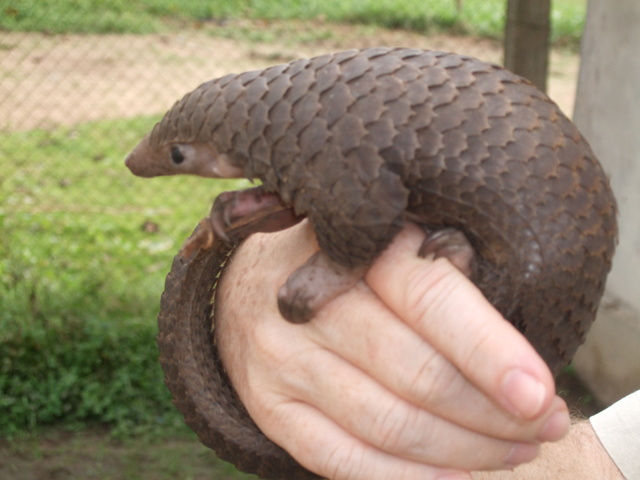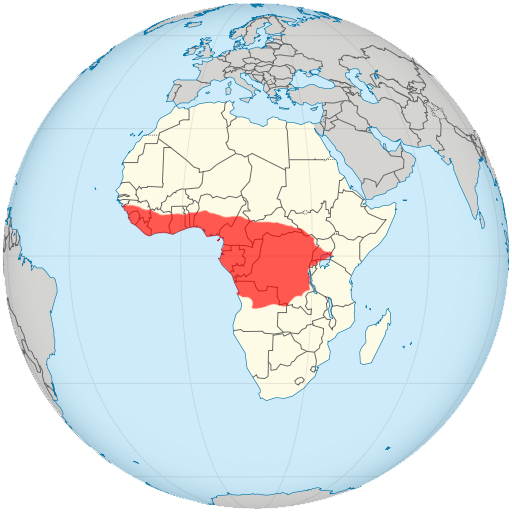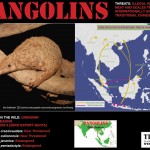Sharing the love for Africa’s three-cusped pangolin!

The three-cusped pangolin (Phataginus tricuspis) gets its name from a unique feature found on their brown, keratinous scales: each one has three points (or keels) on the exposed edge – kind of like a Douglas Fir pine cone!
This species can reach a head-body length of about 46 centimeters and typically weighs less than two kilograms.
They are well-adapted for life in the trees, having a long, prehensile tail that — like the long-tailed pangolin — has a bare sensory pad at the tip to aid in mobility and gripping.
These nocturnal, semi-arboreal creatures are found in both primary and secondary lowland, tropical, moist forests, as well as in mixed savanna-forest habitats and in occasionally in agricultural lands.
As with most pangolin species, the three-cusped pangolin can survive in modified habitats, provided there are ample food sources (ants, termites, and other insects) and no hunting or persecution from humans.
During the day, they can be found sleeping in tree hollows, curled up in epiphytes, or in a forked branch of a tree.
After a pregnancy that is said to last around 150 days, this creature gives birth to only a single young, typically in the winter.
Sadly, the three-cusped pangolin continues to be unsustainably harvested for bushmeat, traditional medicines, and cultural rituals and uses throughout its range.
The International Union for the Conservation of Nature (IUCN) reports that this species is regularly recorded in international trade and is “by far the most common of the pangolins found in African bushmeat markets”.
In fact, a 2002-2003 field study found it to be the fourth most harvested species across 47 sites that were sampled, after the brush-tailed porcupine, the blue duiker, and the giant pouched rat.
- IUCN Conservation Status: Near Threatened (since 2008)
- Protection: Present in many protected areas and protected from international trade under CITES Appendix II
- Range: Angola, Benin, Central African Republic, Congo, Côte d’Ivoire, Equatorial Guinea, Gabon, Ghana, Kenya, Liberia, Nigeria, Rwanda, Sierra Leone, Sudan, Tanzania, Togo, Uganda, and Zambia — its presence is uncertain in Burundi
Although there are currently no estimates on its population size nor densities, the three-cusped pangolin – also called the tree pangolin or the African white-bellied pangolin – is thought to have undergone a decline of 20-25% over the last fifteen years.
Experts believe it could quickly be up-listed to more threatened conservation status, despite being the most common of the African forest pangolins.
More research on this animal is certainly needed and there is a pressing need to develop and enforce protective legislation throughout its range, in order to ensure a secure future for the three-cusped pangolin.
Sources:
“Phataginus tricuspis,” International Union for the Conservation of Nature Red List of Threatened Species, accessed 28 January, 2012
“Three-cusped pangolin (Phataginus tricuspis),” Arkive, accessed 28 January, 2012
Image #1 by Valerius Tygart (own work) via Wikimedia Commons
Image #2 via Wikimedia Commons, with range added by author




![Pangolin Scales Seized in Hong Kong, 2 Arrested [Photos]](http://pangolins.org/wp-content/uploads/2015/08/WorldPangolinDay2013-01-copy-150x150.jpg)

![‘Pangolins in Peril’ [Video]](https://www.pangolins.org/wp-content/uploads/2011/10/TRAFFICPangolinCurled-150x150.jpg)
Comments are closed.